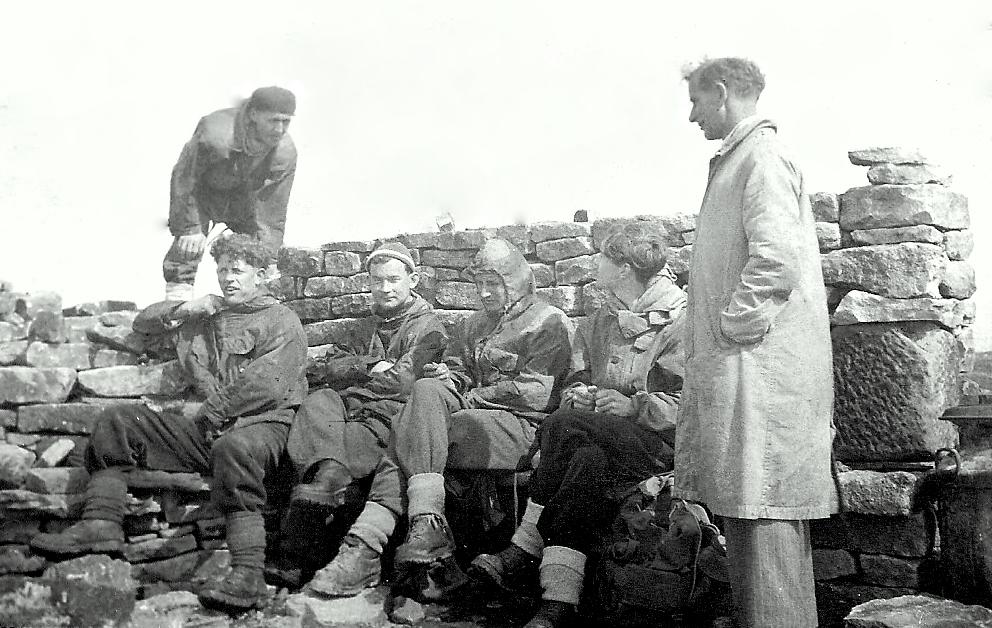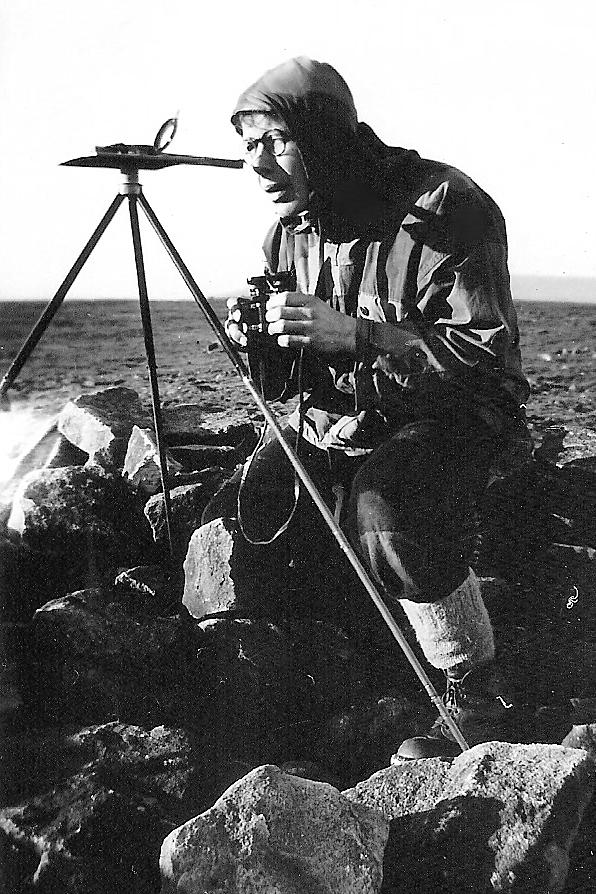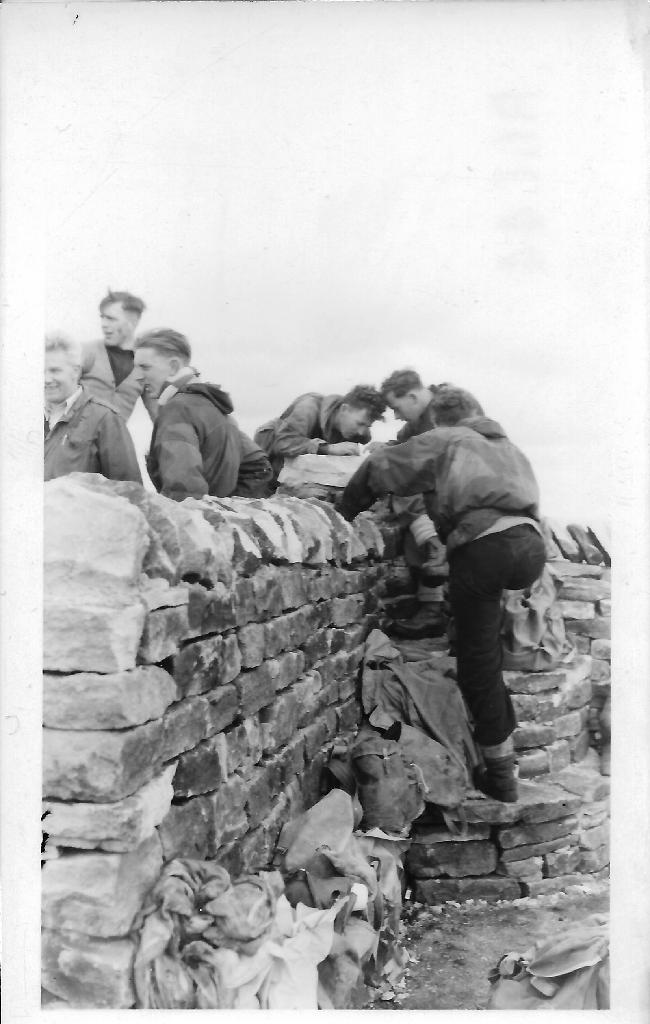| JOURNAL 2021 |
| North Craven Heritage Trust |
The Shelter has provided cover for countless walkers for nearly 70 years. In the summer of 2020 it was dismantled and rebuilt with replacement flag seats. A new, replica bronze toposcape was also installed to replace the original. Unlike the building of the original shelter all the materials such as the sand, cement and flags were lifted to the sight by helicopter. The following article was written by one of the team who built the original shelter.
There was a period when some sections of the Cave Rescue Organisation wanted to concentrate their resources on underground rescue only, and as a result the Ingleton Fell Rescue Team was formed in February 1951. It was to cover a specified local area, the northern boundary being the Sedbergh to Hawes road, the eastern boundary a line from Hawes to Settle, the southern being the Settle Slaidburn Quernmore road, and the western boundary the Sedbergh Kirkby Lonsdale road.
The principal instigator in establishing a local fell rescue service was Ingleton garage proprietor Reg Hainsworth who was a founder member of the CRO and chief warden at that time. With local Gritstone Club colleagues and friends with climbing, caving and fell walking interests, he had no difficulty organising a team that worked in conjunction with the adjoining Upper Wharfedale Fell Rescue Association, The RAF Mountain Rescue service and the West Riding Police via Sgt. Nock who was in charge of the Ingleton police station.
The decision to organise a beacon on the summit of Ingleborough to commemorate the forthcoming coronation was made at the Ingleton Fell Rescue team a.g.m. on 7th Feb 1952; but it was at a meeting on 1st March 52 that, amongst all the regular rescue business, the chairman (Reg Hainsworth, of course) outlined a scheme to erect a crosswall shelter on the summit together with a view indicator suitably inscribed as a memento of the Coronation of Queen Elizabeth II. The scheme was readily approved, It is significant to point out here that Andrew Brown was a local builder, probably the only member with the skills to construct the shelter, so his enthusiasm was essential, the remainder of the team simply being willing labourers. It was recognised that the whole matter hinged upon legal issues and the first contact with the solicitor of the Lord of the Manor was authorised.
If we were to raise funds to help with material costs, it became obvious that the secretary/treasurer Clifford Humphries, a local school teacher, would need some help and Arthur Salter another local teacher took on the role of a sort of Public Relations/Press Officer. Peter Walker the Ingleton newsagent became Treasurer for Appeals.
By the 9th June 52 Mr Hornby, Ingleton Lord of the Manor had given permission for the shelter and even contributed 5 guineas. The County Planning Officer had also approved the scheme. I suspect it may be a bit more controversial these days and certainly take a little longer!
The site was chosen and foundation work had begun on the 5th June long before the correspondence with the Ministry of Works regarding the summit archaeology had been concluded. Bearing in mind that most people worked at least a half day on Saturdays it was not easy to coordinate voluntary labour, with people attending their individual club meets and weekend family commitments. As a consequence the skilled work was generally done on Sundays but sometimes it was possible to transport materials midweek. Reg having the local dealership for Ferguson tractors had access to the appropriate vehicles and he knew all the local farmers, which was invaluable in getting building materials up Cod Bank onto Little Ingleborough. Some was moved by hand up the final steep slope but on occasions a Fergie with a link box made a suicidal trip up the rake, the final part of the current footpath from Gaping Gill to the summit. When Eric Middleton was driving with Harry Schofield sat on the front of the bonnet, they devised a bailout plan which thankfully they never had to implement. I remember helping Maurice Rowling film one event, from a safe distance, with Harry Schofield driving and Peter Walker sat on the bonnet as ballast. There were many logistical problems, various vehicles getting stuck, some for many days including Reg’s breakdown truck but I think the tractor and trailer driven by Eric Middleton seemed to be the most successful. The most assured way of moving small quantities was in your rucksack but building tools and materials become heavier the further you carry them. Building stone had to be found and carried from the upper millstone slopes as nothing could be used from the summit plateau and water came from the Swine Tail spring and was stored in milk kits.
The design of the Ingleborough shelter evolved from freehand sketches and knowledge of other mountain shelters, but the fact that the structure has withstood the most hostile environment for 68 years stands testament to the skill of Andrew Brown, with some professional help from Harry Schofield who worked for Andrew at that time. Although the building work took place during the most appropriate time of year and the weather would have been taken in to account in organising work parties, it is the constant wind that stands out in my memory.
Possibly the most controversial issue was the view indicator; not the design or wording, after all there was correspondence with the Queen concerning permission to use the proposed inscription; but the material to be used and the cost. All members of the team had different opinions. Earthenware like the one on Ben Macdui was a popular choice but doubts about its durability caused concern. My father was the local watchmaker and jeweller in Bentham so I was tasked to see if he could supply a bronze view indicator. Other members had been instructed to obtain quotes for different materials but of course no one could get a price without a detailed drawing. Because sighting depended on good weather the production of a final drawing became dangerously late and eventually some of the bearings were established using maps and Maurice Rowling, an engineer, produced the final plans, just in time. After many arguments about quality and price, the quote of £45-10-0 that my father had obtained for a bronze toposcope from Robert Pringle & Sons a London silversmith was approved. As there were other quotes, for alternative options, including; aluminium at 2 copies of the toposcope for £20; brass £14; and from Messrs Doulton £50 for earthenware; one can imagine the long debate.
Looking back through the minutes it is interesting to note the effect that press publicity had, not only on raising finance but the interest shown from all parts of the country and indeed the world. A 90 years old man recalling his first ascent of Ingleborough; a query whether Snaefell on the Isle of Man could be seen; and a suggestion we should rebuild one of the “hutments” on the summit rather than a new crosswall shelter. There was obvious concern about the preservation of the summit archaeology with Arthur Raistrick and the Yorkshire Archaeology Society amongst those raising the issue. Not all correspondents were supportive; one man was angry enough to write and tell us he had removed a stone from the half built structure. One archaeology group thought that to help preserve the summit settlement an explanatory plaque should be fixed to the shelter. Although this was agreed, the group that suggested the plaque failed to provide it. In view of current archaeological opinions perhaps this may have saved some embarrassment!
Interviews were given to the press and some reporters even visited the summit works including the BBC recording an item for the “North Countryman” programme, for which they gave a donation of 10 guineas to the fund. Contributions received were very small by today’s standard, perhaps the gift of 15cwt of cement was outstanding. As labour was voluntary the greatest expense was the cost of tractor fuel. In presenting their accounts Cliff Humphries and Peter Walker never had more than £70 in the kitty.
In completing the construction of the shelter and installing the toposcope, just in time for the coronation on the 3rd June 1953, efforts were concentrated on the beacon which was organised in conjunction with Ingleton Parish Council. The beacon or bonfire was and is a traditional Ingleton celebration of national events. The logistics of getting the combustible materials on to the summit of Ingleborough is a serious undertaking but Reg Hainworth and other locals had past experience. Tractors and trailers had to be organised with manpower to load and unload and local knowledge of the terrain was vital. Rescue of bogged down vehicles became more efficient, the Rowling family at nearby High Leys farm providing emergency rescue equipment including bales of straw. The materials were manhandled by a long continuous line of helpers up the final steep slope onto the summit plateau where the expert bonfire builders did their stuff. Basically, this was a mountain of old tyres stacked around a core of scrap timber with the odd drum or two of old engine oil! At the post bonfire clean-up I recall having to remove a substantial amount of metal, mostly the wire reinforcement from the tyres.
The beacon was to be ignited by a flaming torch carried in relay by pupils (boys) from Ingleton school.
| Stage 1. | The Square to halfway up Storrs Common by Ian Nicholson & Roger Todd. |
| Stage 2. | Halfway up Storrs to the first gate in Fell Lane by Brian Robinson & Stanley Bargh. |
| Stage 3. | First gate in Fell Lane to Red Gait Head by Edwin Horne and Edmund Hutchinson. |
| Stage 4. | Red Gait Head to foot of first rake by Brian Murfin & John Morphet. |
| Stage 5. | The final three rakes by Cyril Bibby & Kenneth Watkinson. |


